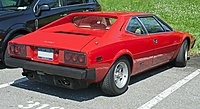Ferrari GT4
| Ferrari 308/208 GT4 | ||
|---|---|---|
Kerb weight 1,150 kg (2,535 lb) (dry) | | |
| Chronology | ||
| Predecessor | Dino 206/246 GT | |
| Successor | Ferrari Mondial | |
The Dino 308 GT4 and 208 GT4 (later Ferrari 308 GT4 and 208 GT4) were
Design
The GT4 was a groundbreaking model for Ferrari in several ways: it was the first production Ferrari to feature the rear mid-engined V8 layout that would become the bulk of the company's business in the succeeding decades, and was the first production Ferrari with Bertone rather than Pininfarina designed bodywork. Pininfarina was upset by the decision to give cross-town rival Bertone the design, considering all they had done for Ferrari.
The design has sharp, angular shapes, entirely in contrast to its delicately curvaceous two-seater predecessor, the Dino 246 GT and GTS, and was controversial at the time. Journalists compared it to the Bertone-designed Lancia Stratos and especially the Lamborghini Urraco – all were designed by Marcello Gandini, and Lamborghini had quickly become one of Ferrari's foremost competitors. The Dino 308 GT4 exactly copied the Urraco's layout, and styled by the same designer, it looked rather similar. Gandini was since not again hired for the design of a Ferrari.
From the cockpit the driver sees only the road. Enzo Ferrari himself took a major role in its design, even having a mock-up made where he could sit in the car to test different steering, pedals and cockpit seating positioning.[3]
Specifications

The chassis was a
The 2.9 L (2927 cc) V8 was mounted
308 GT4

The Dino 308 GT4 was introduced at the Paris Motor Show in October 1973. Its chassis number was 07202 and it was the only example produced that year. It was painted in Azzurro Metallizzato (Light Blue Metallic).[4]
The 308 GT4 later went on sale as a 1974 model and gained the "Prancing Horse" badge in May 1976, which replaced the Dino badges on the hood, wheels, rear panel and the steering wheel while retaining the Dino 308GT4 logo on the rear boot lid. This has caused major confusion over the years by owners, enthusiasts and judges. During the energy crisis at that time many prospective owners were hesitant to buy such an expensive automobile not badged "Ferrari", being confused at the significance of the Dino name. Dino was Enzo Ferrari's son who died in 1956, and his name was to honor his memory on the models it was placed.

In an effort to improve sales until the 1976 official re-badging, Ferrari sent out factory update #265/1 on July 1, 1975 with technical and cosmetic revisions in many areas. Some of these revisions were implemented piecemeal by dealers. Some made all the revisions while some just made a few. This leaves many 1975 GT4's with a variety of modifications which are hard to document as "correct" to aficionados who may not understand the complicated series of events surrounding this model year. Some of the revisions included adding Prancing Horse badges, repainting in the
There were two series of GT4; the earlier cars featured a twin distributor engine and foglamps mounted in the front valance. Later cars had a single distributor engine, with foglamps mounted behind the front grille.
208 GT4

Introduced at the
Power output is 170 hp (125 kW) at 7700 rpm for a top speed of 220 km/h (137 mph). Smaller Weber 34 DCNF carburetors, a lower final drive ratio and skinnier tires completed the technical changes for the 208. Chrome (rather than black) accents outside and the lack of fog lights were external visual indicators of the smaller-engined GT4. Inside the 208 GT4 featured a black rather than silver dash facing.[6]
The
References
- ^ "Designer". ajovalo.net. Retrieved 2012-02-08.
- ^ a b "Dino 308 GT4". auto.ferrari.com. Retrieved 25 November 2019.
- ^ a b "Ferrari 308 GT4". 7 May 2007. Archived from the original on 2 February 2017. Retrieved 29 December 2016.
- ^ "FIRST PRODUCTION V8 FERRARI SET FOR GOODING'S PEBBLE BEACH SALE". Magneto Magazine. Retrieved 1 April 2024.
- ^ "Dino 208 GT4". auto.ferrari.com. Retrieved 25 November 2019.
- ISSN 0177-8862.
- ^ Lingner, p. 17
Bibliography
- Buckley, Martin; Rees, Chris (1998). World Encyclopedia of Cars. London: Anness Publishing. ISBN 1-84038-083-7.
- "Ferrari Dino 308 GT4". Retrieved 24 November 2006.
- Covello, Mike (2003). Standard Catalog of Ferrari 1947–2003. Lola, WI: Krause Publications. ISBN 0-87349-497-0.


